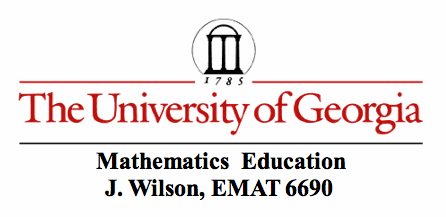
8th grade Instructional Unit
Unit 2 – Exponents & Square Roots Review
Unit 3 – Pythagorean Theorem Instructional Unit
by
Nancy Perzel
Day 1 - Squares and Square Roots Review
1) Using one rubber band, make a square on your geoboard. What is the length of the side? What is the area?
2) Find the square on your geoboard with the smallest area. What is the length of the side? What is the area?
3) Find the square on your geoboard with the next smallest area. What is the length of the side? What is the area?
4) Find the square on your geoboard with the largest area. What is the length of the side? What is the area?
5) Can you predict the size of the next largest square? What would be the length of the side? What would be the area?
This can be done in a variety of ways:
1) Using actual geoboards
2) With dot paper or graph paper
3) Using the “Grid” or “Dotted Grid” feature on GSP
4) Using an Interactive Geoboard found on the website for the National Library of Virtual Manipulatives (http://nlvm.usu.edu/en/nav/vlibrary.html)
Once students have been given enough time to complete this activity, bring the class back together for a whole-group discussion. Do you see any patterns? What is the relationship between the side length and the area? Can you come up with a rule? (Exponent, perfect square) Is there an inverse relationship? What can you do to the area to get the resulting side length? Can you come up with a rule? (Square root, radical, rational number) *Be sure to review these key vocabulary terms in your discussion!
Activity 1:
** The directions for this construction are included on the GSP file for students to use. Square Root Lab
|
AREA: 1 cm2 |
LENGTH = ___________ cm |
|
AREA: 4 cm2 |
LENGTH = ___________ cm |
|
AREA: 9 cm2 |
LENGTH = ___________ cm |
|
AREA: 16 cm2 |
LENGTH = ___________ cm |
|
AREA: 25 cm2 |
LENGTH = ___________ cm |
|
AREA: 36 cm2 |
LENGTH = ___________ cm |
|
AREA: 49 cm2 |
LENGTH = ___________ cm |
|
AREA: 64 cm2 |
LENGTH = ___________ cm |
|
AREA: 81 cm2 |
LENGTH = ___________ cm |
|
AREA: 100 cm2 |
LENGTH = ___________ cm |
|
AREA: 121 cm2 |
LENGTH = ___________ cm |
|
AREA: 144 cm2 |
LENGTH = ___________ cm |
|
AREA: 169 cm2 |
LENGTH = ___________ cm |
|
AREA: 196 cm2 |
LENGTH = ___________ cm |
|
AREA: 225 cm2 |
LENGTH = ___________ cm |
What is the relationship between the area of the square and the length of the side of the square? Describe in your own words the definition of a square root.
* For additional practice you can play the “I Have... Who Has…?” game
Instructions:

Examples of cards:


Activity 2:
Encourage the students to use the table above… what two perfect squares does the area of 50 cm2 fit between? A: 49 cm2 and 64 cm2. Since the √49 = 7 and the √64 = 8, that means the √50 is between 7 and 8.
To check your estimation – use the GSP construction, manipulating the area of the square until you get 50 cm2. (You could also incorporate the use of calculators here.) What is the corresponding side length? What do you know about the relationship between these two numbers?
Let’s try a few more… Use the estimation strategy first, and then check your answer in GSP or by using a calculator.
√90 =
√114 =
√42 =
Give students some time to create a few non-perfect squares on their own…
Activity 3:
Students can explore the CCGPS Task below, in groups or individually.

Extra Practice/ Homework:
1) Let’s say that Mrs. Perzel wants to sew a fringe on the edges of a square tablecloth with an area of 500 cm2. What is the length of each side of the tablecloth? How much fringe would I need to buy? Please solve this problem first using estimation and show your work. Then check using a calculator, Graphing Calculator or by creating a sketch on GSP.
Additional Technology Resources:
- http://www.brainpop.com/math/numbersandoperations/squareroots/preview.weml
- http://www.brainpop.com/math/numbersandoperations/rationalandirrationalnumbers/preview.weml
Return to 8th grade Instructional Unit
Return to Nancy Perzel's Home Page